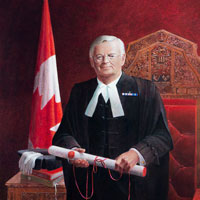Native Women
Cree artist Jerry Whitehead says that many people try to define his style of work but he refuses to limit himself in this way. His fondness for vivid colors incorporated with family themes give his work deep cultural meaning. It reaffirms the centrality of his culture, his indigeneity, life experiences and importance of family.
The painting depicts eight women each wearing a different colour. They each have on a dress, boots and a pendant. They stand against a blue starry background and green grass. The artist has signed the painting on the bottom edge of the woman in yellow's shawl. It reads: "J WHITEHEAD 2--2".
His approach to art is influential. It responds to the need to illustrate and denaturalize systems of colonial thought that constrain the Indigenous expression of cultural and political agency.
It is appropriate that ‘Native Women’ was donated by the Native Women Association of Canada to be predominately displayed in the Senate. The Senate serves as a representative chamber of Canadians of all cultures. The art piece entitled Native Women not only serves to illustrate the diversity of this country but gives representation to the cultural reality of First Peoples.
In the late 1960s and early 1970s Indigenous peoples united to confront a disconnection of cultural knowledge and language. It became a time of cultural resurgence and Indigenous renaissance.
The existence of politics in Art is indisputable. Art demands an audience and dialogue. Indigenous art is no exception. It has the ability to strengthen traditions, reinforce sovereignty, support ancestral bonds and engage in terms of reconciliation. Indigenous artworks such as Native Women provoke a sense of emotionality.
Native Women argues for the importance of preserving the term matriarchy and to understand its deep structure. Matriarchal structures have been mistreated within the Canadian cultural narrative but remain a significant part of the Indigenous cultural memory.
Whitehead’s style of art, his use of bold colors and his inclusion personal themes are iconic. There is a complexity of meaning in his work. It is deepened when the viewer is provided with appropriate contextual knowledge of it.
It was only recently that Indigenous art came to find its rightful place in Canadian society. The meaning of Indigenous art is now less of a mystery. Who produced those works, from which communities they originated, and the subject matter depicted in these works is no longer irrelevant.
What better place to view society’s perception of Indigenous people than in the nation’s capital and especially in the Senate. Normally, it is featured on settler architecture, on stamps, in museums, in art galleries and on coins in the context of developing a national cultural identity.
Much of what Indigenous peoples experienced has given rise to a distinctive artistic style. It provides a voice to many of those challenges. The cultural, economic, political, social and emotional complexities of the Indigenous existence has become central for Indigenous artists who find themselves crossing over and collapsing more traditional artistic expression.
It is obvious that Jerry Whitehead’s heart, soul and memory of his ancestors, as well as his commitment to his culture reside within his artworks. Works such as Native Women offer greater insight into the dynamics of culture, namely family, community and our perpetual connection to our homeland.
Native Women
Cree artist Jerry Whitehead na teloet pogoelg ta oen geto gitg tan tel logoetj pasna mo geto nagensigo natel. Tan teligsatg tel milamog ag oiagatog neatjoino oigemag na me mesgig teloag tan teli elnooltimg.Melgigenatog negem tan telteg tan teli elnoimg, teli elnoeg negam, tan teseg tan sapotasitj ag negem oigemag.
Ola napoigagen na neoatog ogomoltjin tesitjig epitjig emset nasgemititj piloamog. Emset nasgemititj magot, tepotg ag epseson. Gagemoltitjig glogoetjoig mosigisg ag stogenamog emsigo. Ta oen gisi napoigiget na mesganeteg ot oisonem eponegel tan eit oataptep omagotemg, teloag: “J. WHITEHEAD 2-2.”
Mesgig teloag tan telipsogteg tan telogoetj. Oesgotg tan tel notag nemitasigten ag napoigasigten tan telaiotjig elnog ag me elnoitasoltineo tan tel nemitog tan teloltigo ag tan teliag ositgamo.
Tetapoatagetitjig na Native Women Association of Canada igenemoetotitj ‘Native Women’ tan gagepiteteo tan eteg Senate. Senate na eteleoôgotitjig otjit tan tesit oen tel milamogsit Canadianag. Ola napoigagen teloisig Native Women na mo paseg oesgotemog tan tel milamogsit nematjoino ag mao tan tel oiagatasig tan tel mimatjoltitjig elnog.
Oetjgoategemg 1960s ag me genegtjitjg 1970seg naelnog maoitapenig matenemeneo tan tel tepgisteg elno tan teleg ag otlisotimoeo. Pemiagep na tan tel megitetadig elnooltimg ag gesigaoi apatjatasigep.
Eteg na politics Artigtog ag getjitasig. Art na notag nemitasigten ag osgotasigten. Elnoeoei art na mo atji teptjigegtenog. Eteg tan gisi atjigenateo tan teliagep, melgigenatog tan tel ilsomsoltigo, apogenematg tan telagomog gemistiminagiig ag apigsigtagen. elnoeoei amalitagen stige Native Women na gisalesg temig tan teli angitasin.
Native Women na gigatjasig tan tel gepemeg maliaptemeneo glosoagen epiteoei ag ensetemeneo tan tel temig tan oetjiag ag tel melgigenag. Epitepeoi tan tel pemiag na oelotasig tan telitasoltitjig Canadianag gato me gepmitetasig tan tel migoitetemititj elnog.
Whitehead tan tel napoigigetj, tan tel oegetog gesigsamoog ag tan tel oiagatog negem tan teleg na telneneasig otlogeoagen, milamog tan teloag otlogeoagen. Ag me atji temig tan totjo telimotj ta oen etliangapteg tan gogei gisatog.
Atel mo piasgi sag elnogisitagen oetjitog tan teteo Canadian Society. Tan teliosoatasig elnogisitagenei na me oelnenasig nige. Ta oen gisitog, tan tet teleiaoitj, ag tan gogei giatasig na mo nogoo malioosoatasinog
Mo etenog atji gelolg tan tet gisi nemitem tan tel nemitasig elnoeiei ag ta gato tan pemgopitj gepetnol ag the Senatigtog. Gagisg nemites aglsieoigan, stampigtog, museumg, art galleriil ag solieogtog tan geto oiagalotjig elnog.
Pogoelg na tan elno gisi nemitog na ilsotg tan tel napoigasig gogei. Igenematg gelosoagen otjit na tan gogei gisi sapotasitj elno. Tan teli emtoeg elnoimg, economic, political, social ag emotional telnemisoltitjig ag telitelemsoltitjig na me pogoelg tel oiagatasig otlogeoagen elno tan nemisoltitjig asogemitatjig ag eltatjig tan me elnoei tan teloatitjig.
Oel nemitasig tan Jerry Whitehead otgamlamon, ta oenit, ag tan omisgeminagig angitasoagen, ag tan tel gepmitetg elnoei na eteg otlogeoageng. Napoigagen stige Native women na igenemoetog me oel nemitasigten elnoei, oigemag, otan, ag tan tel siaoasig tan telagotemog egtmagemigemino.
Roger Lewis is the Curator of Mi'kmaq Cultural Heritage at Nova Scotia Museum in Nova Scotia.

Object details
Artist
Jerry Whitehead
Cree culture (Peter Chapman First Nation)
Melfort, Saskatchewan, 1957
Title
Native Women
Date
2002
Medium
Acrylic on canvas
Dimensions
H: 74 cm
W: 89.5 cm
Credit
Senate's Artwork and Heritage Collection
Image copyright
Jerry Whitehead



 The Honourable Noël A. Kinsella
The Honourable Noël A. Kinsella The Honourable Muriel McQueen Fergusson
The Honourable Muriel McQueen Fergusson